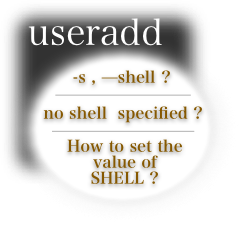Posted :
useradd is used to create a new user . It is also used , to set the default options , used , when creating a new user .
One of the options , that can be set , when using useradd , is the login shell .

-s LOGIN_SHELL or --shell LOGIN_SHELL options
The
login shell , for a new user , can be set by using the
-s LOGIN_SHELL , or --shell LOGIN_SHELL options
.
LOGIN_SHELL , must be a path . Valid shell
paths , can be gotten , from /etc/shells .
@root:~$ cat /etc/shells # Print the paths for valid # shells . # /etc/shells: valid login shells /bin/sh /bin/bash /usr/bin/bash /bin/rbash /usr/bin/rbash /bin/dash /usr/bin/dash
If the account is supposed , to not to be able
to login , then /sbin/nologin ,
can be used as a login shell , for the account .
In this case , if the account tries to login , /sbin/nologin
will display
a message , that the account is not available for login .
This can be used for example , with daemon accounts .
@root:~$ /sbin/useradd -s bash user-one useradd: invalid shell 'bash' # The operation fails , because # bash is not a path @root:~$ /sbin/useradd --shell /bin/bash user-one # Add a user named user-one , with a # login shell of : bash , located at # /bin/bash @root:~$ cat /etc/passwd | grep user-one # grep user-one , from /etc/passwd user-one:x:1001:1001::/home/user-one:/bin/bash # user-one has a login shell of /bin/bash @root:~$ /sbin/useradd --shell /sbin/nologin daemon-one # Add a user account , named daemon-one , with a # login shell of : /sbin/nologin @root:~$ cat /etc/passwd | grep daemon-one # grep daemon-one from /etc/passwd daemon-one:x:1002:1002::/home/daemon-one:/sbin/nologin # daemon-one has a login shell path , set to : # /sbin/nologin @root:~$ su daemon-one # change user to daemone-one This account is currently not available. # When daemon-one tries to login , the message # that he will get , is : This account is currently # not available @root:~$ /sbin/useradd --shell /bin/invalid_option user-invalid-shell # useradd will not check , if the path is # a valid path . # For example , here user-invalid-shell is added . # The provided shell path is not a valid one . @root:~$ su user-invalid-shell # The user will fail to login , because # the specified shell is not a valid one su: failed to execute /bin/invalid_option: No such file or directoryIf no login shell is specified ?
If
the -s LOGIN_SHELL or
--shell LOGIN_SHELL
options are not used , then
useradd ,
will
check the /etc/default/useradd
file , for the variable named SHELL .
If
it exists , and is not commented out ,
then
the account is created with a
login shell path , as the one pointed by the
SHELL variable .
If
the SHELL
variable is not defined , or is commented out ,
then the default shell path , for the newly created
user account , will be left empty .
If the login shell path is empty , then the
default shell will be : /bin/sh .
@root:~$ cat /etc/default/useradd | grep SHELL # grep the value of SHELL , from : # /etc/default/useradd SHELL=/bin/sh # If the -s LOGIN_SHELL or # --shell LOGIN_SHELL options , # are not used with useradd , then # the SHELL variable will be # checked . # If it exists , and is # not commented out , then the user # login shell , will be the one pointed # out , by the path set , in : SHELL . @root:~$ /sbin/useradd user-two # Create a user , named user-two . # No login shell was specified , as # such the SHELL variable in # /etc/default/useradd is checked . # It exists , and it is not commented # out , as such the user will have a # login shell path , as the one pointed # by the SHELL variable . @root:~$ cat /etc/passwd | grep user-two # grep user-two from /etc/passwd user-two:x:1004:1004::/home/user-two:/bin/sh # user-two has a login shell of /bin/sh @root:~$ cat /etc/default/useradd | grep SHELL # grep the value of SHELL , from : # /etc/default/useradd # SHELL=/bin/sh # The SHELL variable is commented out , # as such , when useradd is used without # the -s LOGIN_SHELL or --shell LOGIN_SHELL # options , the login shell path will be left # empty . If the login shell path is empty , # then the default shell is : /bin/sh @root:~$ /sbin/useradd user-three # Create a user named user-three @root:~$ cat /etc/passwd | grep user-three # grep user-three from /etc/passwd user-three:x:1005:1005::/home/user-three: # user-three default login shell is # empty , because when creating # user-three , the -s LOGIN_SHELL or # --shell LOGIN_SHELL options , were not # used , and the SHELL variable , in # /etc/default/useradd was # commented out . @root:~$ su user-three # Change user to user-three $ echo $SHELL # Print out the current shell /bin/sh # user-three default login # shell is /bin/shHow to set the value of
SHELL in
/etc/default/useradd
useradd -D -s SHELL_PATH ,
or useradd -D --shell SHELL_PATH ,
can be used to set
the value of SHELL ,
in : /etc/default/useradd .
@root:~$ cat /etc/default/useradd | grep SHELL # grep the value of SHELL from /etc/default/useradd # SHELL=/bin/sh # The SHELL variable is commented out . @root:~$ /sbin/useradd -D -s /bin/bash # Set the SHELL variable value in # /etc/default/useradd , to : # /bin/bash # Valid SHELL path values , can be gotten # from : /etc/shells @root:~$ cat /etc/default/useradd | grep SHELL # grep the value of SHELL from /etc/default/useradd # SHELL=/bin/sh SHELL=/bin/bash # The SHELL variable is now set to # /bin/bash @root:~$ /sbin/useradd -D # Display the default options # used with useradd GROUP=100 HOME=/home INACTIVE=-1 EXPIRE= SHELL=/bin/bash SKEL=/etc/skel CREATE_MAIL_SPOOL=no